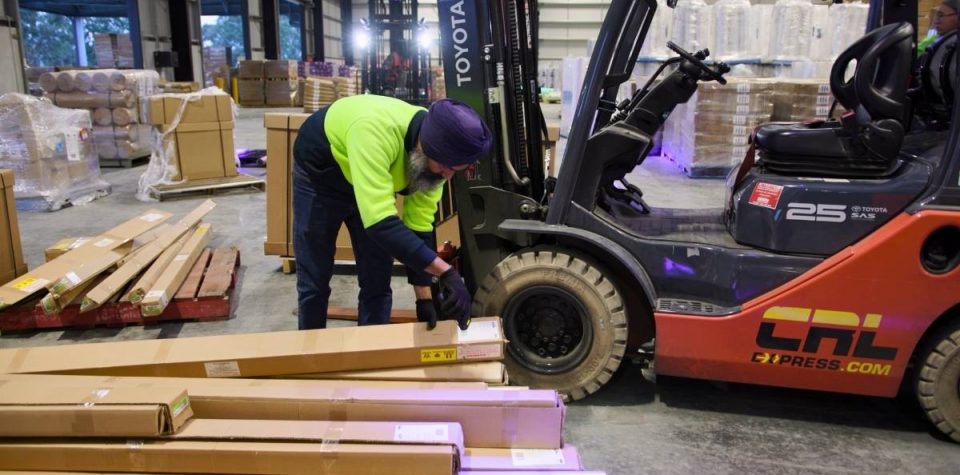Table of Contents:
- From a Small Flock to the Big Stations
- Click Go The Shears.
- Software Steps In: Orchestrating the Wool Symphony
- Beyond the Bale: The Knitting Up of Australian Wool Logistics
From its small beginnings in late 1790s to the big sheep stations of today, the logistics of wool production has played a major role in the history and development of Australia.
Now jump upon the lever, lads, and heave and heave away,
– The Castlereigh Shearing, Banjo Patterson
Another bale of golden fleece is branded ‘Castlereagh.’
The Australian Outback is synonymous with wool production. This natural fibre, prized for its softness, warmth, and versatility, still forms a significant part of the Australian economy. But getting wool from the backs of happy sheep to cosy sweaters and knee-warming blankets in boutiques across the world involves some complex logistical processes. And these days, a large part of this fine-wool dance is intricately orchestrated by sophisticated software systems.
In this blog post, we are going to muster some facts about the history of wool production in Australia. We’ll cover the logistics of wool marketing with a wide comb (shearers will get the joke) and a long blow, throw the facts on the wool sable, skirt out the dags and class it AAA M for your reading pleasure. All of that before smoko. So let’s get started on the first run.
From a Small Flock to the Big Stations
The history of wool production in Australia is if you’ll pardon these several puns, a rich tapestry woven into the fabric of the nation itself. It’s a story of resilience, adaptation, and the enduring bond between the Australian landscape and its people.
Macarthur and Marsden’s merinoes
The roots of Australia’s wool industry trace back to 1797 when John Macarthur and Reverend Samuel Marsden imported some Spanish merino sheep to the colony. Before the arrival of these sheep, the colony had relied on fat-tailed sheep from the Cape of Good Hope, primarily valued for their meat.
Macarthur’s breeding program spanned nearly a quarter-century before it yielded a sufficient wool harvest for auction. The turning point came in 1821 when the first consignment of Australian wool found its way to Garraway’s Coffee House in London. This coffee house in the City of London had been the first place in England to sell tea. It had also been a venue for the sale of furs by the Hudson’s Bay Company.
The backbone of the economy
By 1840, Australia was producing over two million kilograms of wool annually. The prosperity of the wool industry transformed numerous squatters and pastoralists into wealthy magnates, propelling the wool trade into a booming business by the 1880s. It was during this era that sheep breeders congregated in the newly bustling urban centres of the colony, partaking in extensive stock and wool transactions that shaped Australia’s economic landscape. An article in the Sydney Mail of October 16th, 1897 recorded that
“one of the most remarkable sights in Sydney is that of the Wool Exchange in full blast. Both buyers and brokers are men of weight and substance and responsibility in the community, but when the auctioneer puts up a lot the buyers spring to their feet, wave their catalogues over their heads, and shout their bids frantically at the seller… It is not unusual for 100,000 [pounds’] worth of wool to be put through during an afternoon.”
Click Go The Shears.
Wool’s journey starts in the heart of rural Australia, where Merino sheep graze on the sprawling pastures of Outback stations. Twice a year, gangs of shearers arrive to meticulously remove their fleeces. Shearing is extremely hard work and the shearers themselves are superb athletes. Indeed, it has been estimated that during the course of a day’s shearing a shearer will expend the energy equivalent of running two marathons.
Shearing is heavily influenced and structured by traditional methods that were developed in the early days of Australia’s sheep industry. In the pre-machine days, woolshed were quiet places where stories were told and poems composed to the soundtrack of clicking shears. It was during this simpler time that the structure of the shearers’ working day was established.
Four runs to knockoff
Each day of shearing is divided into four runs of two hours. The shearers stop for a five minute break in the middle of the run. Shearers will time the shearing of the last sheep before each break to get a catch, which is an extra sheep they can shear during the break. Morning smoko is a half hour break at ten o’clock, lunch is from twelve until one, and afternoon smoko is at three PM. Knockoff is at precisely five-thirty but is a shearer has timed it right, he or she will manage to grab another catch which cal legitimately be shorn after the knockoff time.
Shearing shed logistics
Shearers are paid by the sheep, so the farm workers and shed hands have to ensure that the catching pens are kept full and that the count outs are accurate. With so much hands-on work to be done, there’s little room for digital logistics in a shearing shed.
Nevertheless, logistics still plays a vital role in ensuring that the job flows smoothly from start to finish. Let’s look at a few of the things a farmer has to consider for a successful shearing.
- Mustering and dagging. Sheep have to be mustered from the outer regions of the station and brought in to the yards prior to shearing. The sheep have to be checked for dags (dung around the tail) and sorted into lines according to age, sex and wool type.
- Woolshed equipment. The runholder or farm manager will need to ensure that all of the equipment and consumables required during shearing are on hand prior to the arrival of the shearers. For this, they may liaise with a local stock and station company or order online for delivery by a local transport operator. Essential items include tally books, wool bales, stencil paint, paper grinding discs for sharpening shearing gear, and scourable spray paint for marking injured or sick animals.
- Shedding up and counting out. Sheep are loaded into the shearing shed and attached covered yards to keep them dry. The farmer has to ensure that there are enough sheep on hand for at least one full day’s shearing. But care has to be taken to avoid over-filling the shed. If too many sheep are penned up, there is a danger smother when one or more animals are trampled in overfilled pens.
When a shearer finishes each sheep it is released down a chute into the counting out pens. At the end of every run, the sheep are counted out and the shearer’s tally is entered into the tally book. At the end of the day, the numbers are added up to provide each shearer with the number of sheep they have shorn. Counting out is a highly skilled job with no room for error as the shearers know exactly how many animals they have shorn and will argue ferociuosly if the tallies don’t match.
Away to the woolstore
The fleeces of shorn greasy wool are classed according to fineness, colour and strength. They are then are then pressed into 200 kilogram bales and transported to regional woolstores. Expert classers at the woolstore assess each bale of wool, categorising them based on various factors like fibre diameter, length, and strength. This meticulous process ensures that the wool reaches the right buyers, from high-end fashion houses seeking the finest Merino wool to manufacturers of carpets and insulation.
Traditionally, wool auctions were the primary method of selling. Growers would bring their prized fleeces to bustling auction floors, hoping for competitive bids. However, the rise of online wool-selling platforms has revolutionised the market. These platforms allow growers to list their wool electronically, connecting them directly with buyers worldwide.
Software Steps In: Orchestrating the Wool Symphony
Managing the intricate flow of wool – from shearing sheds to shipping containers – is no small feat. This is where logistics software systems step in, playing a critical role in streamlining the process. These systems handle tasks like:
- Inventory management. Tracking wool from farm to buyer, ensuring accurate records and efficient allocation.
- Transport optimisation. Identifying the most cost-effective and efficient routes for wool transportation, considering factors like distance, volume, and urgency.
- Document management. Electronically generating and managing invoices, bills of lading, and other essential paperwork.
- Financial reconciliation. Streamlining financial transactions between growers, buyers, and transportation providers.
By automating these tasks, logistics software reduces errors, saves time, and minimises costs for all stakeholders in the wool supply chain.
Sailing Across the Seas: The Final Leg
Once sold, the wool is dumped into standardised, high-density bales and shipped to international destinations. From bustling ports like Melbourne and Sydney, these bales embark on long journeys across oceans, carrying a piece of Australian sunshine with them.
A small percentage of the clip finds its way into the factories of top fashion brands where it is made into high-end suits and clothes. Most of Australia’s wool, however, goes to China where it is processed and woven into everything from woolley blankets and carpets to wall insulation and upholstery.
Sustainable Strides: Wool’s Ethical Journey
The Australian wool industry takes pride in its commitment to ethical and sustainable practices. Many farms adhere to strict animal welfare standards, ensuring the sheep are treated humanely throughout their lives. Additionally, initiatives like the National Wool Declaration Scheme provide transparency on wool provenance, allowing consumers to make informed choices about the wool they buy.
Innovation and Collaboration
The Australian wool industry is constantly evolving, embracing technological advancements to further optimise its logistics. Digital platforms are increasingly being used to enhance traceability and transparency throughout the supply chain. Additionally, collaborative efforts between industry players and research institutions are fostering innovation in areas like wool processing and packaging, aiming to reduce the environmental footprint of the industry.
Beyond the Bale: The Knitting Up of Australian Wool Logistics
Australia continues to be a global leader in wool production. The industry has evolved to meet modern demands, with a strong emphasis on sustainable and ethical practices. From the shearing sheds of the Outback to the bustling ports where wool is shipped worldwide, the history of wool production in Australia is forever intertwined in the fabric of our nation’s story.
From the sun-drenched paddocks to the shop floors of the world, a complex web of logistics ensures that this natural treasure reaches consumers worldwide. So, the next time you wrap yourself in a cosy wool sweater, remember the remarkable journey it has taken, from the vast Australian outback to the warmth of your own home.



